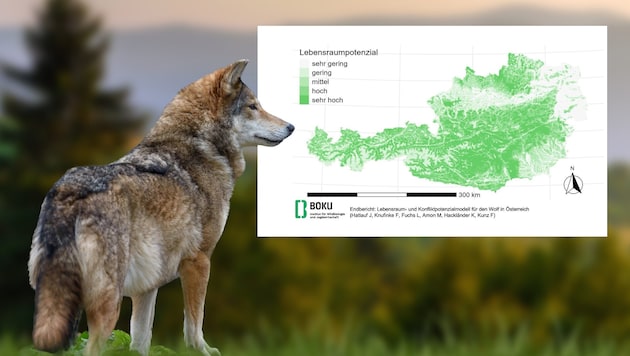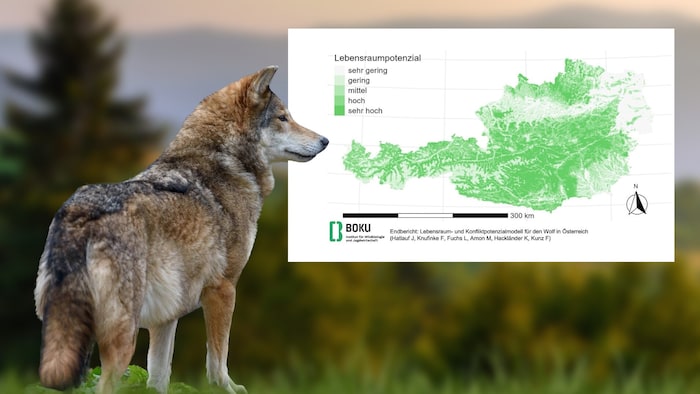Map shows for the first time:
It causes more discussion than any other animal: the wolf. Wherever Isegrim appears, conflicts with farmers and alpine farmers are inevitable. Now a new study by the University of Natural Resources and Life Sciences (BOKU) brings hope: for the first time, it shows where there is room for the wolf in Austria - and where coexistence remains possible.
Since the early 2000s, the once almost extinct hunter has been spreading again in Europe. Around 21,500 animals now live on the continent - with annual growth rates of up to 30 percent.
But while some see the return of the wolf as a triumph for nature conservation, others see growing problems for agriculture and safety ...
There is room - but not everywhere
On behalf of the Ministry of Agriculture (BMLUK), BOKU has for the first time carried out a scientifically sound survey of where wolves can find suitable ecological habitats in Austria - and where these areas are simultaneously used by humans and livestock, i.e. where conflicts can arise.
Map of the potential habitat
Using modern statistical methods, a map of potential habitat was created: forests and sparsely populated areas are particularly attractive for wolves. A second map, on the other hand, shows where things get dicey - for example in mountain pasture regions where livestock are particularly at risk. The combination of both maps results in a so-called "combination model" (see graphic).
Agriculture and Environment Minister Norbert Totschnig emphasizes the importance of the scientific approach: "The large carnivore wolf is no longer threatened with extinction. In view of increasing conflicts with humans, it is now important to maintain the balance in the natural and cultural landscape and ensure that the wolf does not lose its natural shyness towards humans."
Where wolves are causing conflicts, we need practicable solutions based on scientific findings and dialogue instead of polarization. Ultimately, we need active management.

Landwirtschafts- und Umweltminister Norbert Totschnig
Bild: APA/GEORG HOCHMUTH
For him, the present study is an important building block on the way to functioning and scientifically sound wolf management in Austria. Tyrol's Deputy Governor Josef Geisler also calls for cooperation across national borders: "The potential for conflict in densely populated areas is too great in the long term. However, there are certainly regions in Europe where wolves can spread. Basically, we therefore need Europe-wide wildlife ecological spatial planning that also takes the wolf's habitat into account."
Something is also happening at European level: the protection status of the wolf has been lowered through amendments to the Bern Convention and the Habitats Directive. This makes it possible to implement sustainable wolf management in practice. Austria must now adapt its nature conservation and hunting laws and introduce national wolf monitoring.
Clear rules on mountain pastures and co.
The study therefore shows that Austria offers the wolf space - but this space is limited. Clear rules are needed where alpine pastures, agriculture and tourism meet. But it is precisely in sparsely populated regions and extensive forest areas that peaceful coexistence could be possible.
This article has been automatically translated,
read the original article here.



Kommentare
Willkommen in unserer Community! Eingehende Beiträge werden geprüft und anschließend veröffentlicht. Bitte achten Sie auf Einhaltung unserer Netiquette und AGB. Für ausführliche Diskussionen steht Ihnen ebenso das krone.at-Forum zur Verfügung. Hier können Sie das Community-Team via unserer Melde- und Abhilfestelle kontaktieren.
User-Beiträge geben nicht notwendigerweise die Meinung des Betreibers/der Redaktion bzw. von Krone Multimedia (KMM) wieder. In diesem Sinne distanziert sich die Redaktion/der Betreiber von den Inhalten in diesem Diskussionsforum. KMM behält sich insbesondere vor, gegen geltendes Recht verstoßende, den guten Sitten oder der Netiquette widersprechende bzw. dem Ansehen von KMM zuwiderlaufende Beiträge zu löschen, diesbezüglichen Schadenersatz gegenüber dem betreffenden User geltend zu machen, die Nutzer-Daten zu Zwecken der Rechtsverfolgung zu verwenden und strafrechtlich relevante Beiträge zur Anzeige zu bringen (siehe auch AGB). Hier können Sie das Community-Team via unserer Melde- und Abhilfestelle kontaktieren.









